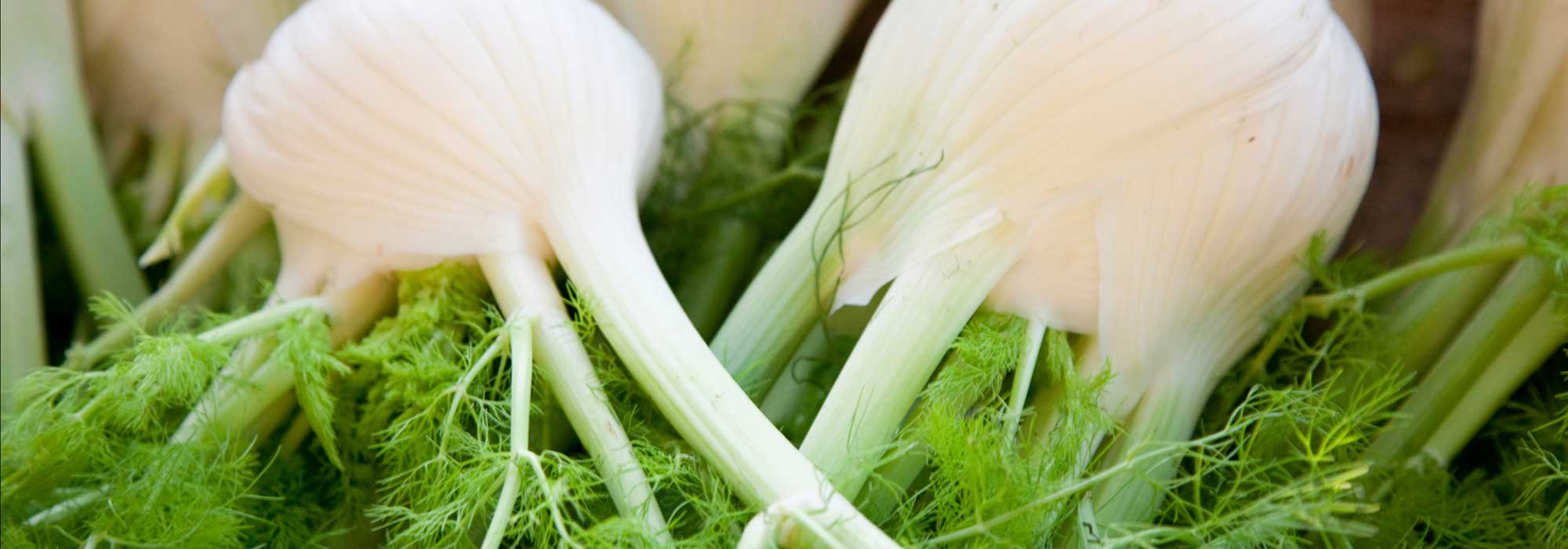
Fennel: sowing, growing, care and harvest
Contents
Fennel in a nutshell
- There are two types of fennel: Florence fennel, grown for its fleshy white bulb, and perennial fennel, valued for its leaves, aromatic seeds, and ornamental habit.
- Due to its Mediterranean origins, fennel enjoys full sun and thrives in well-drained, deep, and rich soil. It dislikes heavy and suffocating soils.
- It can be sown directly in the ground or in containers to be transplanted later in the garden; the key is to sow it at the right time!
- It is a low-maintenance plant, with the main challenge being to prevent it from bolting before the bulb forms.
- Low in calories, rich in vitamins and minerals, and high in antioxidants, it is a very good food that deserves to be more present on our plates!
The word from our expert
Florence Fennel belongs, like Carrot and Dill, to the Apiaceae family and forms a beautiful plant with fine, light foliage, from which we consume the stems, the pearly white “bulb” with a slightly aniseed flavour, the seeds, and also the pollen of fennel, known as the spice of angels, a highly sought-after and relatively expensive product.
Green or bronze fennel is an ornamental and aromatic plant with edible foliage. It is a lovely perennial traveller, as described by Michael in this article, and it will find its place both in the vegetable garden and among perennial flower beds.
Fennels thrive in mild climates and are grown in sunny, fairly rich, well-drained, and deep soil. The regularity of watering will contribute to the production of beautiful bulbs!
In the vegetable garden, fennel grows without difficulty, except that it is one of those very responsive plants that require a minimum of warmth to grow but do not tolerate dry spells well, which cause it to bolt quickly. The art of the gardener then consists of combining the right variety, the sowing period, and managing watering effectively. If some plants do bolt, take comfort in knowing that fennel seeds make a very good condiment that aids digestion. Moreover, fennel flowers are highly appreciated by many insects, including the Swallowtail (fennel is a host plant for this butterfly) as well as numerous beneficial insects for crops.
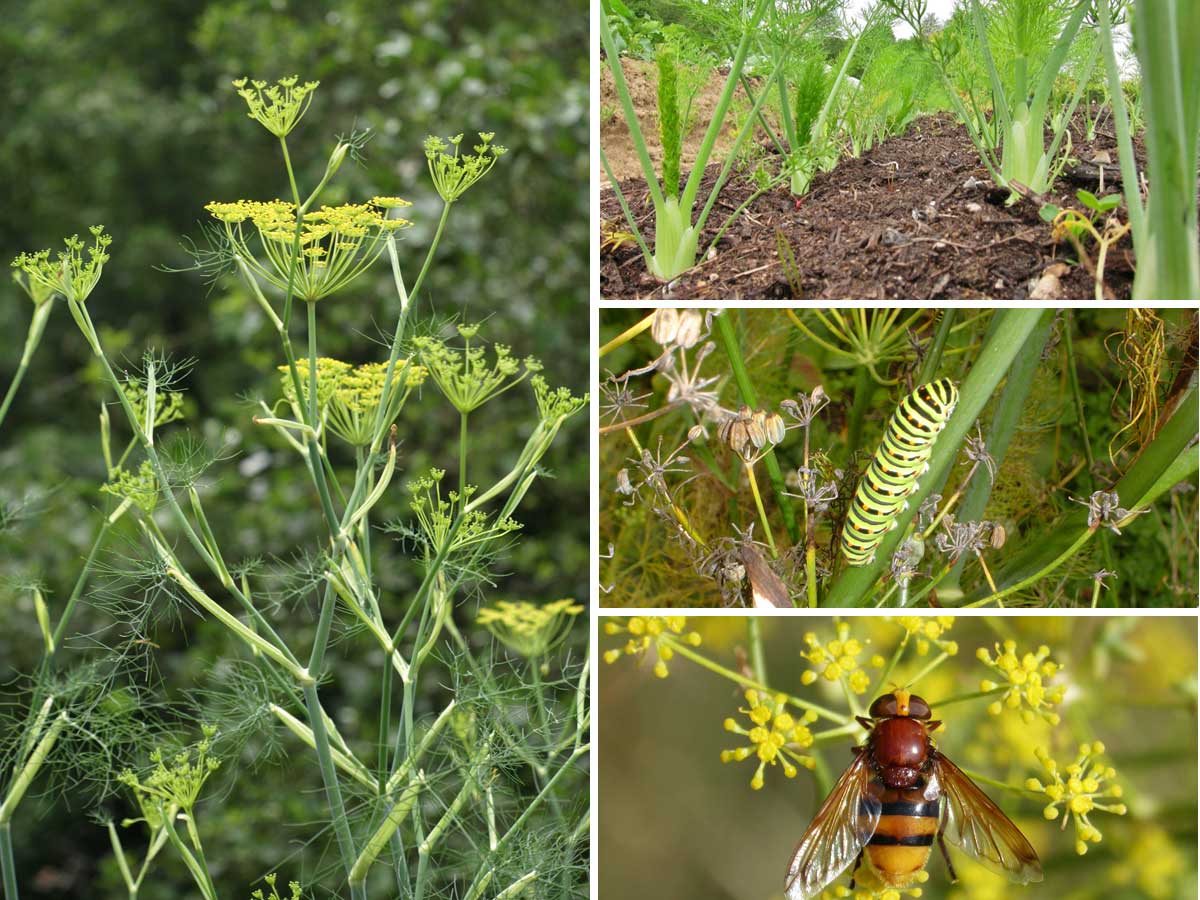
Fennel in flower – Provence Fennel in cultivation – Swallowtail caterpillar – Syrphid fly
Description and Botany
Botanical data
- Latin name Foeniculum vulgare var. azoricum
- Family Apiaceae
- Common name Fennel
- Flowering Perennial grown as an annual
- Height 4 m
- Sun exposure Sun
- Soil type Deep, loose, rich, light
- Hardiness hardy to very hardy
Wild Fennel is native to the Mediterranean basin and Asia Minor, where it grows spontaneously. It has been appreciated since antiquity as a vegetable, condiment, and medicinal plant, particularly among the Greeks, Romans, and previously the Egyptians. For the Greeks, it symbolised strength and youth; for the Romans, it warded off demons and spirits, and victorious gladiators were crowned with fennel. In the Middle Ages, it began to be cultivated in Italy, particularly in Tuscany, where it was popularised by Catherine de’ Medici, who is also credited with its introduction to France. The bulbous fennel is indeed named after Fennel of Florence. It wasn’t until the late 17th century that it began to be cultivated in northern France and the Netherlands.
Etymologically, the name fennel comes from the Latin Foeniculum, meaning “little hay,” due to the lightness of its foliage.
Fennel belongs to the family Apiaceae (formerly Umbelliferae) and forms a beautiful plant with fine, light foliage. It is a biennial or perennial plant grown as an annual for its bulb, branches, seeds, and, more rarely but highly prized, its pollen.
Two species are primarily cultivated:
- The perennial fennel, Foeniculum vulgare, some varieties of which are very ornamental and ecologically interesting, such as Bronze fennel.
- The Florence fennel, Foeniculum vulgare var. azoricum or Provence fennel or bulbous fennel, is cultivated for its white, fleshy bulb.
The root of fennel is white, fleshy, and descends deeply into the soil. Unlike onion, the bulb of fennel is not actually a bulb; it is a tangle of fleshy leaves interwoven with one another. The leaves are arranged alternately on the stem, and their petiole is sheathing. The lamina is finely divided into thread-like strips. Fennel can reach 2.5 metres in height when it flowers. The inflorescence consists of large flat umbels, with small yellow flowers made up of five curled petals without sepals. After fertilisation, they develop into seeds formed of two ovoid and elongated achenes, which are initially greenish and turn brown at maturity.
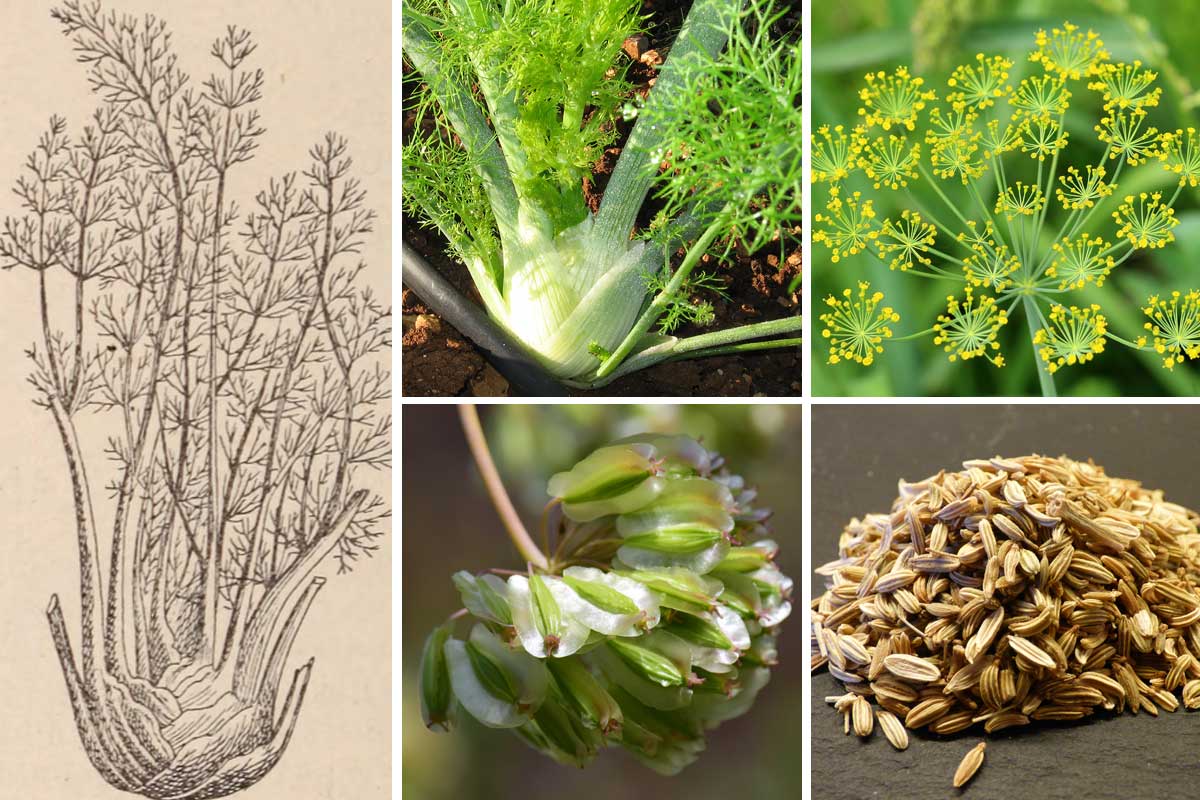
Fennel varieties
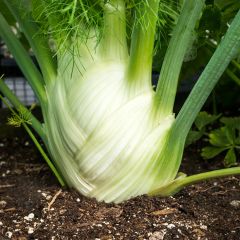
Fennel Crystal (untreated) - Ferme de Sainte Marthe seeds - Foeniculum dulce
- Flowering time August to October
- Height at maturity 60 cm
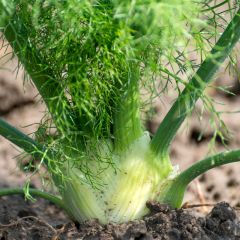
Foeniculum dulce de Florence
- Height at maturity 60 cm
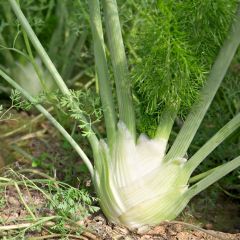
Foeniculum officinalis 'Romanesco'
- Height at maturity 20 cm
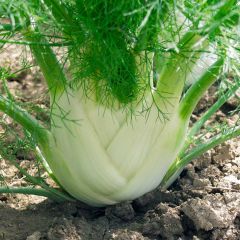
Foeniculum dulce 'Finale'
- Flowering time August to October
- Height at maturity 60 cm
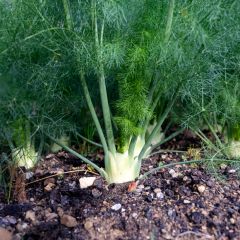
Fennel Selma (untreated) - Ferme de Sainte Marthe seeds - Foeniculum dulce
- Height at maturity 60 cm
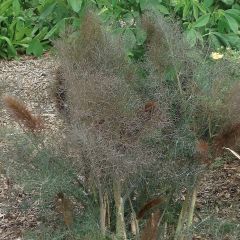
Foeniculum officinale 'Purpureum'
- Flowering time August to October
- Height at maturity 1,50 m
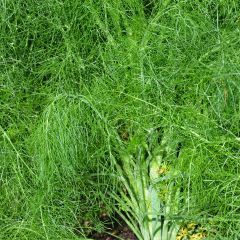
Foeniculum vulgare - Ferme de Sainte Marthe Seeds
- Flowering time August to October
- Height at maturity 1,50 m
Discover other Fennel seeds
View all →Available in 1 sizes
Available in 1 sizes
Available in 1 sizes
Available in 1 sizes
Available in 1 sizes
Available in 1 sizes
Available in 1 sizes
Available in 1 sizes
Available in 1 sizes
Available in 1 sizes
Sowing fennel
Where and when to sow fennel?
Although of Mediterranean origin, fennel can be sown throughout mainland France, and it is important to choose the right varieties according to your climate.
Sowing fennel can be done as early as April under cover, in trays or in buckets filled with good sowing compost, but the ideal time is in June and July directly in place, in well-warmed soil. Fennel germinates at a minimum temperature of 12 °C, but a temperature of 20 °C is more suitable. Germination usually takes between 8 and 10 days.
How to sow fennel?
There are two options for sowing fennel. Either sow directly in the ground. This method of sowing is generally preferred by gardeners as the resulting plants are less likely to bolt prematurely. Alternatively, sow in trays (or in buckets or even in alveolate trays) and the plants will be transplanted later to their final position. The advantage is that you can start earlier by putting these sowings under cover, but the risk is that the plants may bolt more quickly if watering is not regular after transplanting.
Sowing in place:
- Draw deep furrows of 1 cm, spaced 40 cm apart.
- Sow 5 cm apart in the row, or closer if sowing early.
- Close the furrows and then firm down with the back of the rake.
- Water gently with the rose of the watering can.
- One month after germination, it is advisable to thin out, keeping only one plant every 15 to 20 cm.
Sowing in trays for preparing plants for transplanting:
- Fill a tray three-quarters full with sowing compost and firm down with a hand tamper.
- Sow thinly by scattering, then add a centimetre of compost.
- Firm down again with the hand tamper.
- Water from above with a spray and, if possible, by capillarity by placing water in the saucer. Be sure to remove any excess water.
- Place the trays in a warm sheltered spot (under a greenhouse, conservatory).
→ Learn more about sowing fennel in our tutorial!
Planting fennel
How to transplant fennel?
From your young plants sown in trays, buckets or alveolate plates, or even from the best thinned young plants (from direct sowing), here’s how to proceed with the planting.
For young plants from alveolate plate sowing, simply plant a plug plant every 15 cm in rows spaced 40 cm apart. Water gently after planting.
From a sowing in a tray or bucket:
- Dig up a young plant using a small spoon or a dibber
- Trim it if the roots are too long, that is, cut a few centimetres from the bottom and top
- At the final location, make a hole with the dibber, insert the young plant, then firm the soil around the roots with the dibber
- Proceed in the same manner for the other young plants, planting one every 15 cm in rows spaced 40 cm apart.
- Water gently to avoid exposing the roots.
Growing, care and associations
Fennel thrives in sunlight and warmth, with its roots in humus-bearing, deep, and well-drained soil. If compost is needed, it should preferably be applied in autumn, in the form of mature compost (about 3 kg per m²) by scratching it into a depth of 5 cm, after having, as with any vegetable crop, properly loosened the soil.
To limit watering, we recommend mulching the soil with fine successive layers of grass clippings, if possible mixed with dead leaves, starting from the end of May. This protection helps keep the soil moist and also reduces weeding.To achieve nice white bulbs, fennel can be hilled to a height of 15 cm.
Fennel is known to be a poor neighbour that hardly gets along with anything except celery. However, I can assure you that it also does very well with leeks, which actually develop better in proximity to fennel.
Feel free to let a few plants flower, as like all Apiaceae, they are very pretty and particularly appreciated by beneficial insects.
How to prevent fennel from bolting?
This is the main difficulty in growing common fennel. Three points are particularly important:
- Choose a variety suited to your region. Some are well adapted to the South, like the sweet Florence, and others to the North of the Loire, like the early Geneva. Some are also more resistant to bolting, such as the Romanesco variety.
- Respect the correct sowing date. Early sowings often have a higher chance of bolting.
- Water regularly and steadily during the bulb’s growth. And this is probably the most important advice; if the plant experiences water stress, it will seek to reproduce, thus bolting.
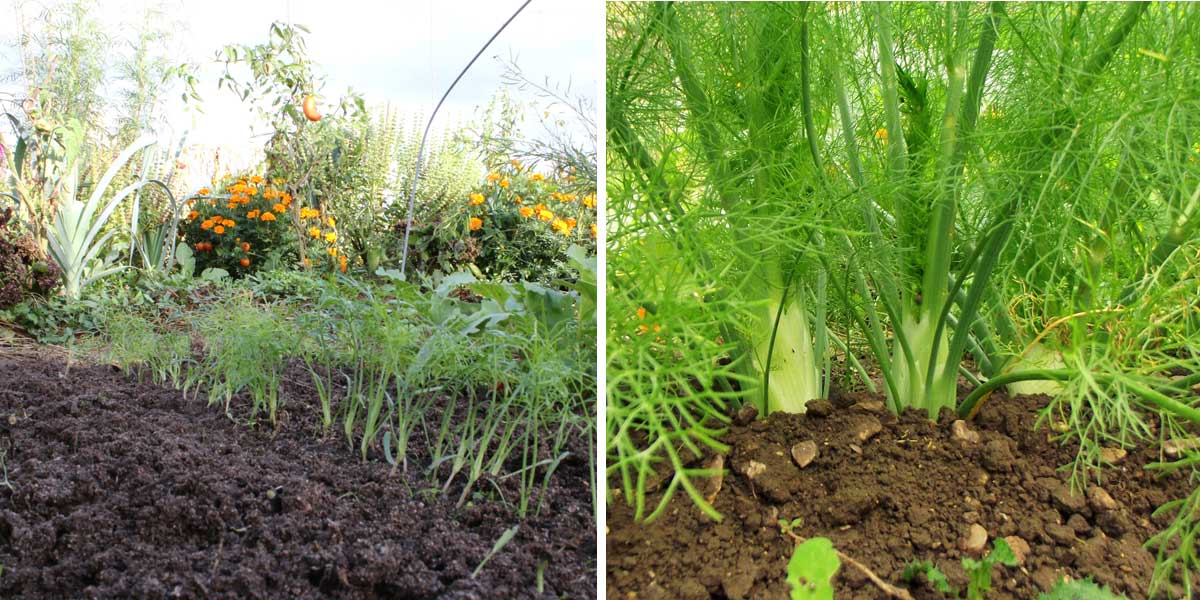
Young fennel plants thinned – Hilled fennel plants
Harvest and preserve
The harvest of fennel occurs approximately three months after sowing and is carried out as needed, as soon as the bulbs have reached a sufficient size. Once they are well-formed, it is important to avoid leaving them in the ground for too long, as they may bolt or sometimes start to rot.
It is a rather tender plant that does not tolerate frost. Fennel, after being trimmed at the foliage level, should be stored in a cellar, in a container of moist sand. The optimal storage temperature is 5 °C. Freshly harvested, fennel can be kept for a few days in the refrigerator or several months in the freezer after being blanched beforehand.
→ Learn more in our tutorial: How to harvest and store fennel seeds
Uses and nutritional benefits
Fennel is used as a vegetable accompaniment on its own or with other vegetables, in starters, main courses, and even in desserts. It can be consumed raw, but it is mainly enjoyed cooked. It can be prepared in gratins, braised in a casserole, stir-fried in a wok, steamed, etc. Its aniseed flavour pairs particularly well with fish, as well as with citrus trees, apples, pears, and of course, olive oil. The outer layer and stalks are often discarded as they are more fibrous; however, they can be used to flavour broths.
Fennel is consumed too little, yet it has numerous health benefits! Firstly, it is rich in various antioxidants (including carotin), molecules that prevent cardiovascular diseases and certain cancers. It is high in fibre, thus facilitating intestinal transit. It is also rich in vitamin B9, vitamin C, and contains iron, the duo against anaemia, as vitamin C helps with the absorption of iron in the body. It also contains phyto-oestrogens, molecules that mimic certain female hormones, thus facilitating lactation, the onset of menstruation, and helping to limit menopause-related disorders. According to studies, these phyto-oestrogens may have a protective effect during adolescence against breast cancer. Finally, fennel seeds are appetising and aid digestion; they stimulate appetite and assist with digestion.
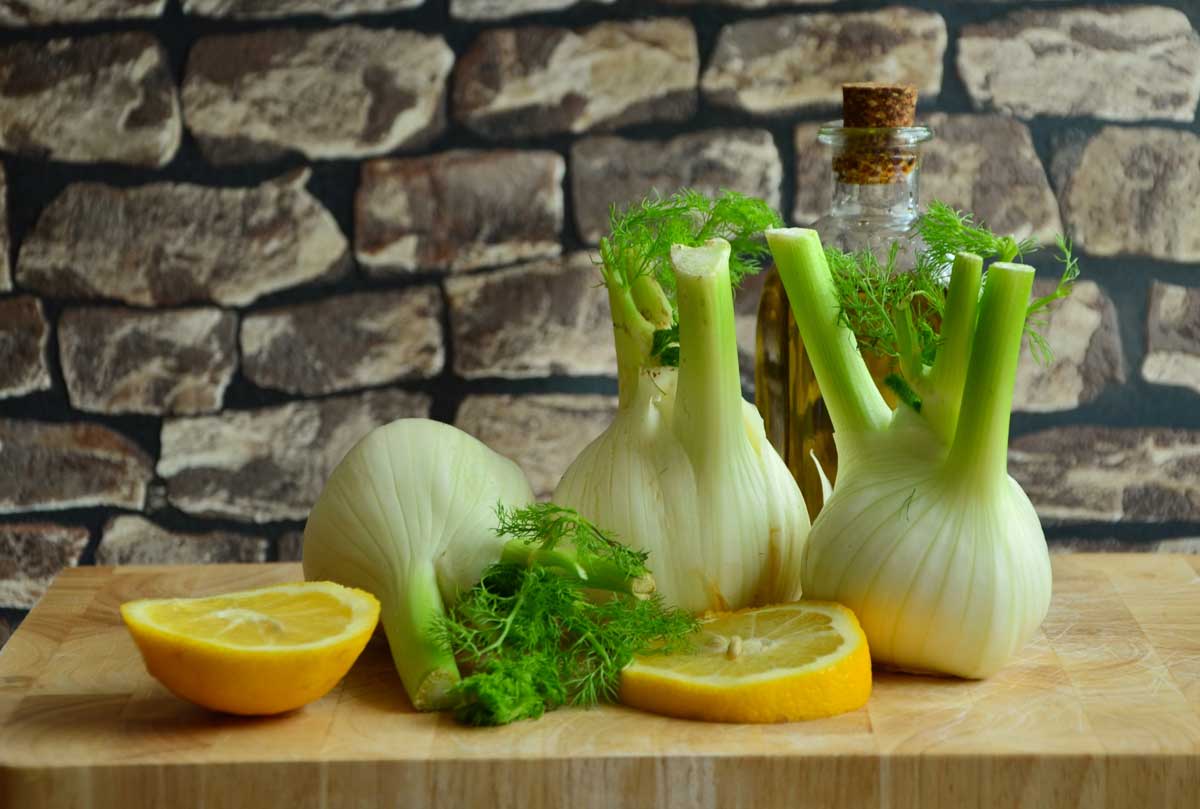
Fennel lends itself to numerous recipes in the kitchen
Useful resources
Discover in our online shop our range of common fennel seeds and perennial fennel.
Frequently asked questions
-
Why are my fennels bolting and not forming bulbs?
Several factors influence the early running to seed of fennel: variety selection, sowing date, and regularity of watering, in addition to well-suited soil for its cultivation and favourable climatic conditions. For more information, see above in the "cultivation, maintenance, and association" section.
-
Does fennel fear frost?
Although fennel is a hardy plant and will regrow without issues the following year, the "bulb" will be damaged by frost, making it less suitable for consumption. It is better to harvest them and store them in a cellar at 5°C in a box of damp sand.
-
Fennel or dill, what’s the difference?
These are two plants that can indeed be confused, as they both belong to the same family but are not of the same genus. The main difference is their fragrance; fennel has a refreshing, slightly sweet aroma, whereas dill is more spicy and pronounced. Fennel is bushier and taller than dill. Finally, the shape of the seeds is truly characteristic: long and elongated in fennel, much smaller for dill.
- Subscribe!
- Contents
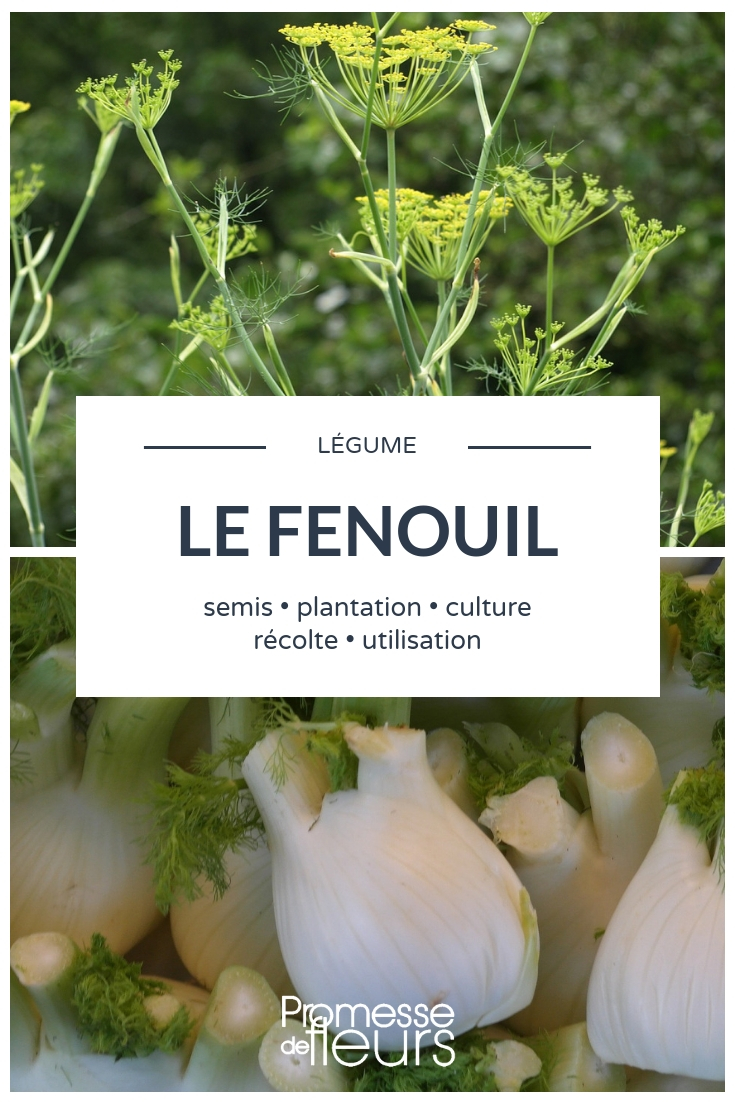































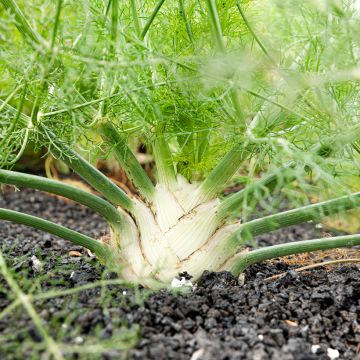




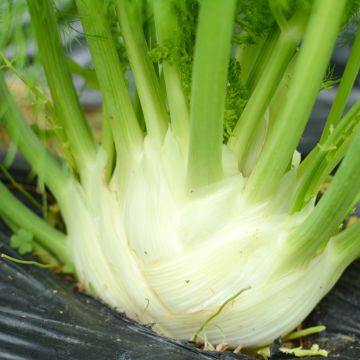

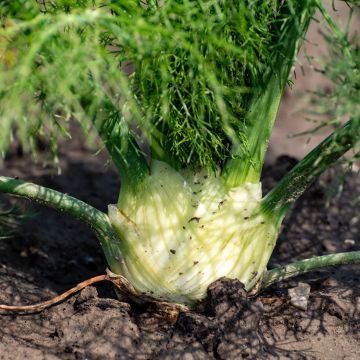


Comments